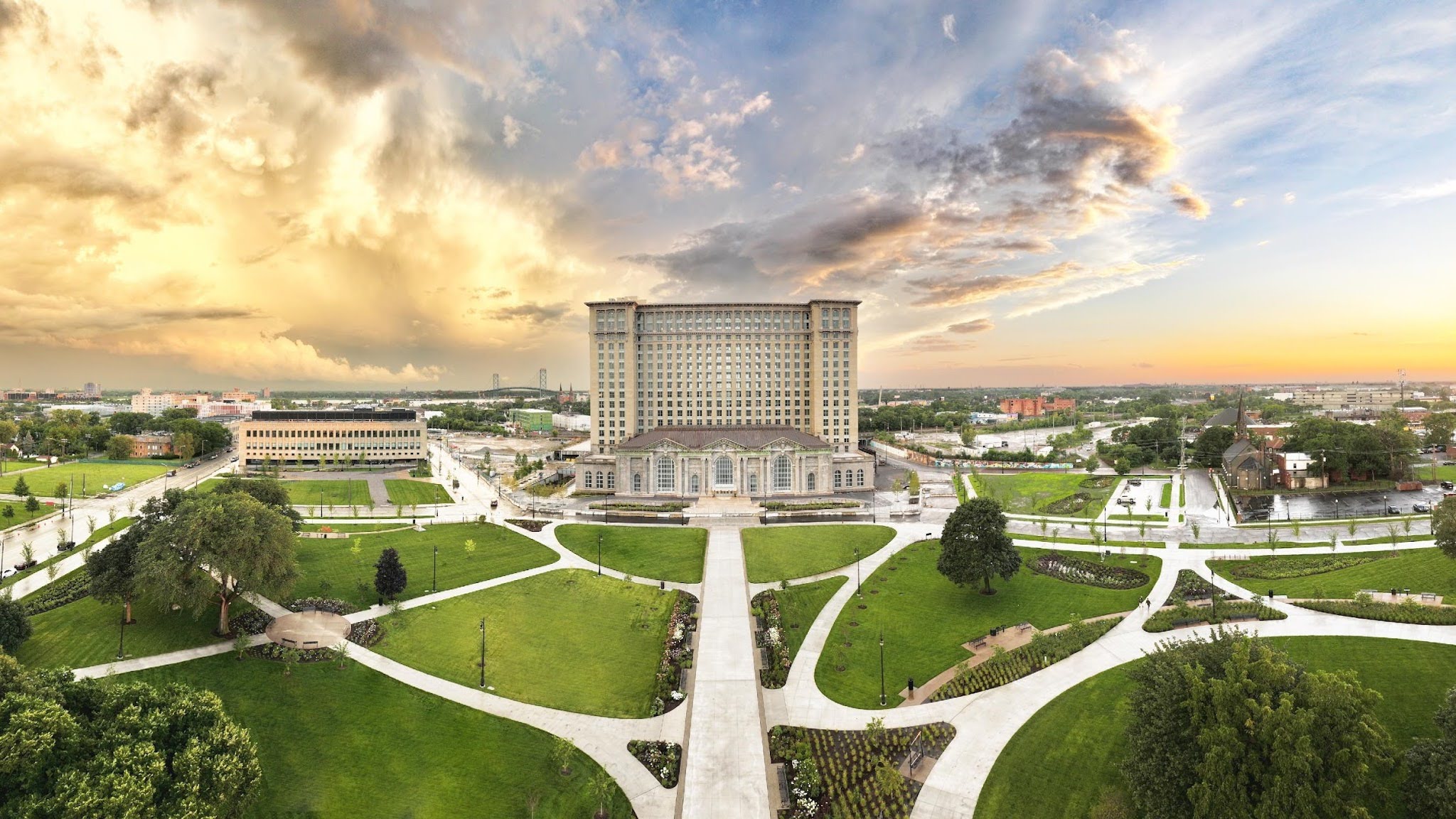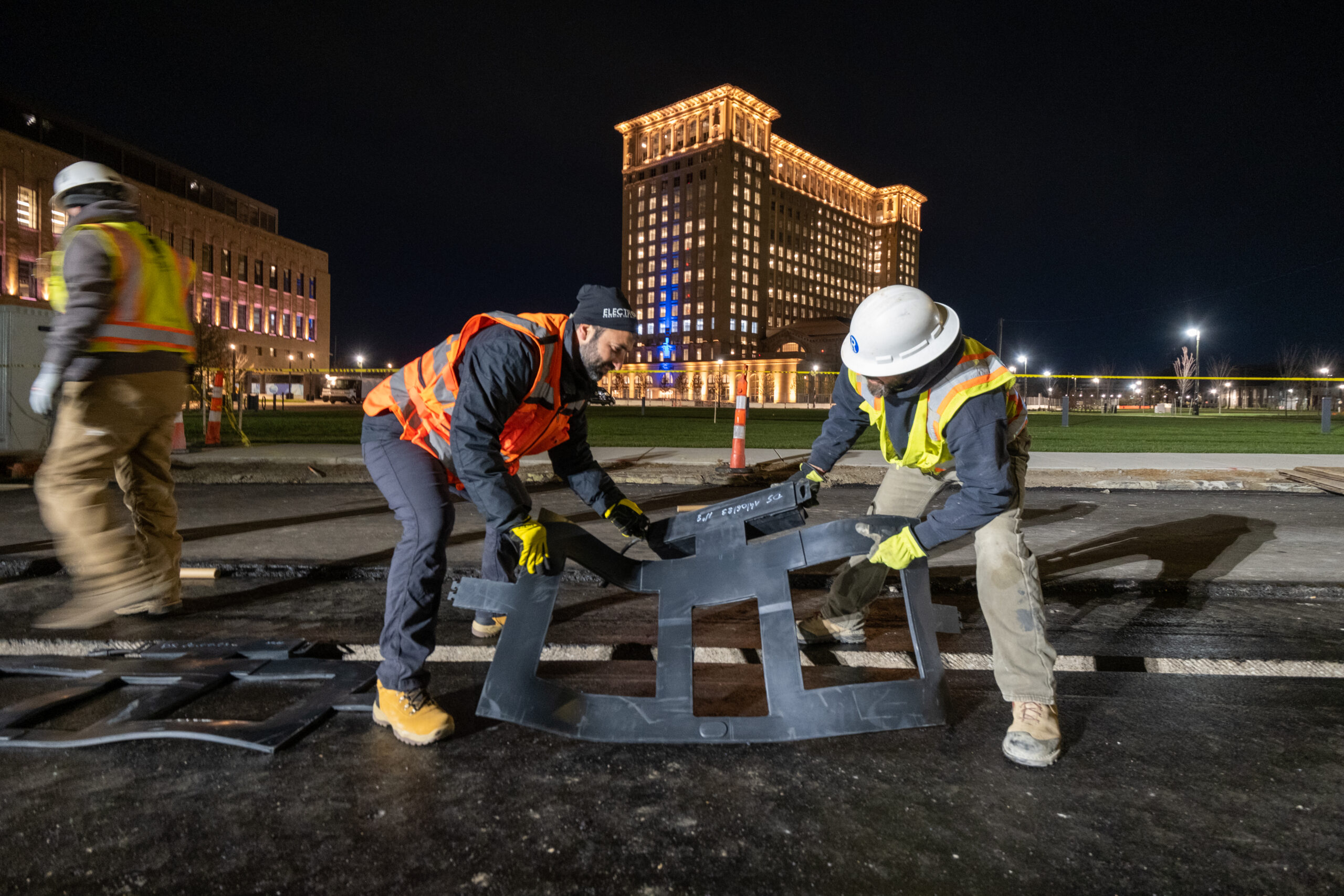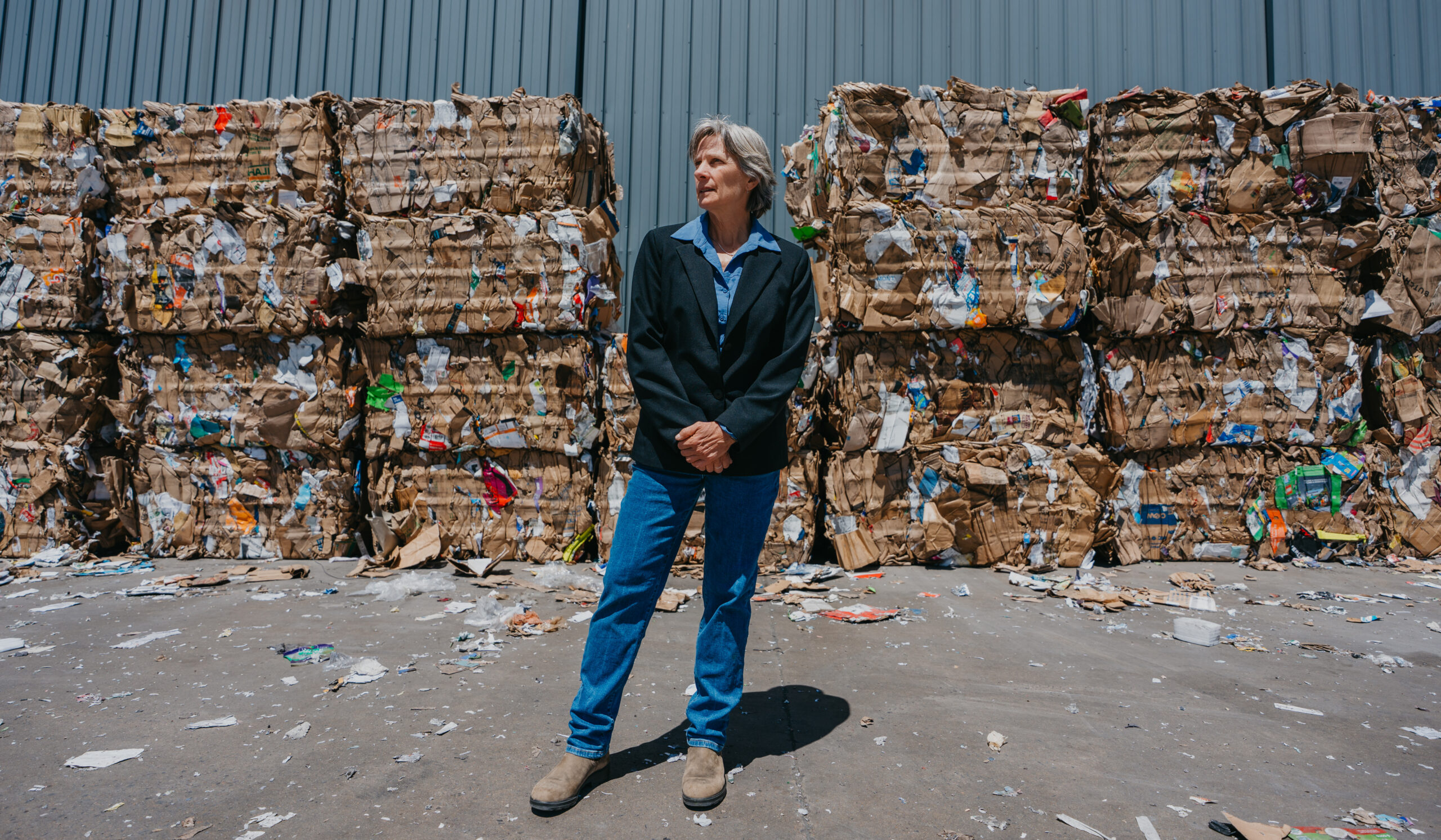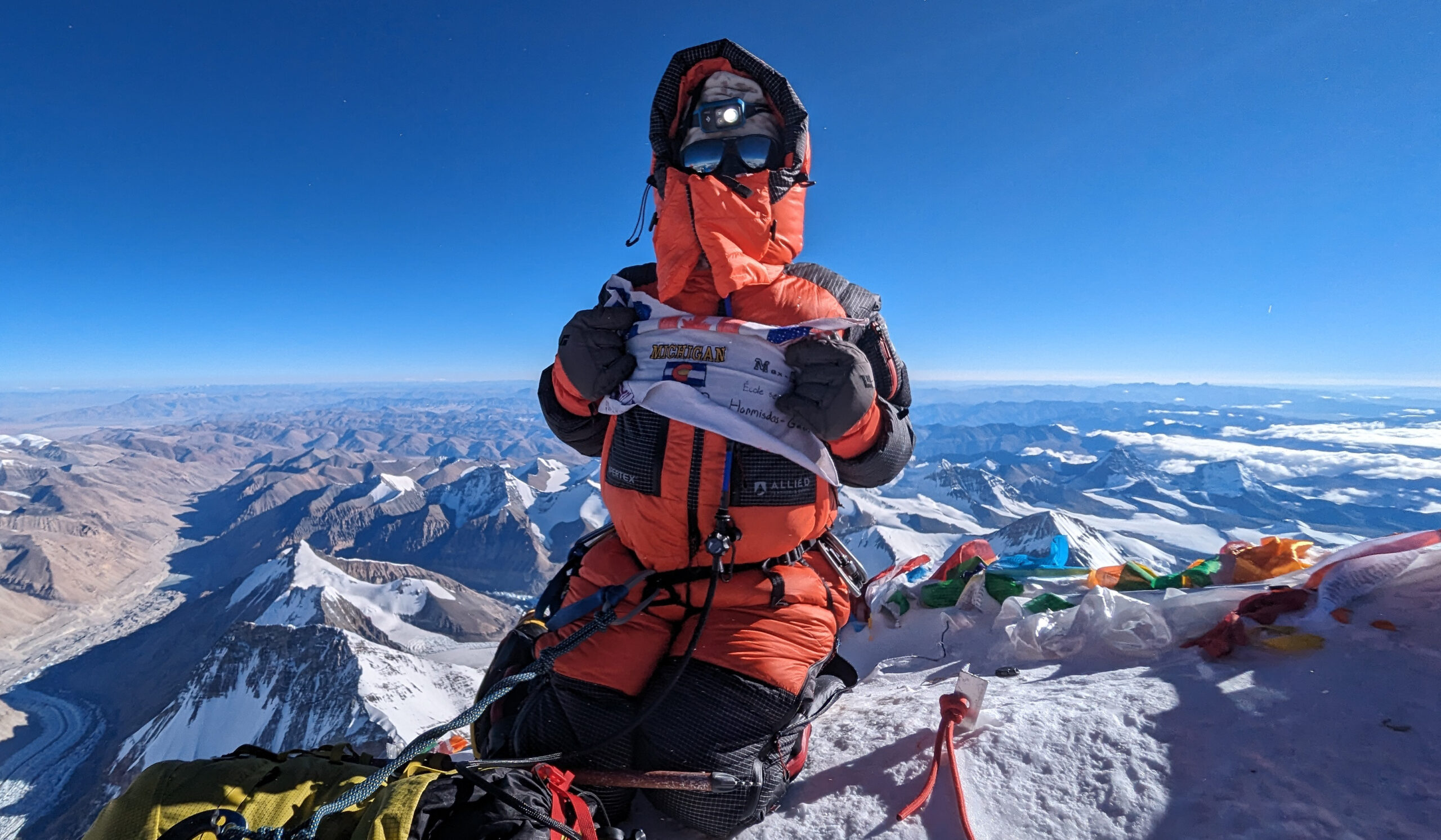The Revitalization of Ruin
•
Header photo by Helmut Ziewers
Recalling childhood drives past the shuttered site with his family, Sean White, ’10, MA’13, said he used to think Michigan Central Station might remain abandoned forever.
Once an icon of ruin in Detroit, Michigan Central Station looks quite different these days. The 18-story Beaux Arts-style fortress, built in 1912, is aglow with modern light fixtures, 1,000 new windows, and a fresh coat of creamy paint. But this is more than just a facelift for the former train station of 75 years. On any given day, you might see autonomous and electric vehicles driving in front of it, drones flying around it, and some of America’s most innovative entrepreneurs imagining inventions inside it.
Just six years ago, this seemed unfathomable — the derelict station had been neglected for over 30 years.

“I didn’t think that it was ever really a possibility that the station would be restored. It was a symbol for Detroit’s decline,” White says. “Now it is a symbol for its continued revitalization, and we at Michigan Central have a once-in-a-lifetime opportunity to help Detroit reclaim its leadership as the world transitions to clean energies and electrification.”
A team led by University of Michigan alumni at the Ford Motor Company-owned Michigan Central Innovation District, also called Michigan Central, is transforming the historic landmark into a vibrant hub of the future.
A ‘Beautiful’ Past
From 1913 to 1988, Michigan Central Station (MCS) was a key entry point to Detroit and Michigan. Its platforms welcomed rail passengers including Charlie Chaplin, Thomas Edison, and presidents Theodore Roosevelt, Herbert Hoover, Franklin D. Roosevelt, and Harry S. Truman. In the 1940s heyday of railways, 200 trains and 4,000 passengers departed each day, while 3,000 businesspeople went to their 9-to-5s in offices above. Designed by the same architects as Grand Central Station in New York, the complex also featured shops and a restaurant. The grand ground floor featured a sprawling, structure-wide lobby with cathedral ceilings more than 50 feet high, marbled floors, tiled walls, Corinthian columns, and massive windows.
Passenger train travel declined drastically over the century, and in 1988, the last train left the station, along with everyone else. Falling apart, covered by graffiti and weeds by the 1990s, MCS became a well-known symbol of decay. Film crews used the lobby as the backdrop for a rubble-filled fight scene in the 2007 film “Transformers,” and the music video for Eminem’s 2009 song “Beautiful” (which has been viewed more than 453 million times). A title card displayed at the beginning of the video, right before Eminem walks through MCS, states: “In 1950, Michigan was 1 of 8 states in America that collectively produced 36 percent of the world’s GNP [Gross National Product]. Detroit was the greatest manufacturing city in the world.”
Despite the viral video, the Detroit City Council voted to destroy the building later that year. However, challenges to the demolition and other factors led to MCS remaining largely untouched, aside from partial renovations and development explorations, until 2018, when Ford Motor Company made a surprising announcement. The iconic automotive company purchased the station and planned to transform it and the area around it into a 30-acre, 1.2 million-square-foot innovation and mobility campus where 5,000 people would be equipped to design and prototype life-changing technologies. Its subsidiary, Michigan Central, would manage the project.
Its mission: “Be a world-leading community, focused on building solutions and skills at the intersection of mobility and society.”
Trains, Lanes, and Automobiles
Construction has been relentless since Ford’s purchase and the reborn MCS is set to officially open this spring. Michigan Central has been enhancing the neighborhood around the station in the meantime, outfitting four key buildings and several adjacent parks and properties.
Josh Sirefman, MUP’03, Michigan Central’s CEO, said building a hub of the future while honoring the past in a place with such a rich transportation and innovation history is the “secret sauce” to why the endeavor has generated so much momentum.
“We could just build new buildings, but there’s a soul there in Michigan Central that I genuinely believe plays a role in creating the kind of environment we’ve become,” Sirefman says. “The station has occupied such an extraordinary psychological, almost spiritual place for the city and region and been so symbolic. Its revitalization is profound, but it’s also about the platform we’re creating — a world-leading ecosystem where the future is being invented.”

Last April, Michigan Central partnered with New York City-based tech startup platform Newlab to found Newlab Detroit (adding to counterparts in Brooklyn and Uruguay) inside a renovated former book depository next door to MCS. The 270,000-square-foot collaborative space is home to a growing number of sustainability and mobility related startups, with 25 companies on board at launch and almost 60 now calling it home. 11,000 square feet of the interior is reserved for advanced prototyping, robotics, and fabrication space.
“We’re an anchor institution and a central convening spot for broader ecosystems . . . we believe the district must deliver much more than just ‘where you go to work.’ There is always something happening here,” Sirefman says.
In November, Newlab member firm Electreon unveiled the first public wireless electric vehicle-charging roadway in the U.S., on a stretch of Detroit’s 14th Street that runs through Michigan Central’s campus — following early testing of the technology at U-M’s Mcity facility. Another Newlab startup, Cavnue, has plans to link Detroit to Ann Arbor with one of the world’s first connected and autonomous vehicle corridors, installing an autonomous public transit vehicle lane on Michigan Avenue which runs in front of Michigan Central Station.

Outside the south side of MCS, Michigan Central is finishing an open-air green space that will become a public park. A recently announced Advanced Aerial Innovation Region covering a three-mile radius around MCS will provide a haven for safe and efficient drone development and testing.
The possibility remains that trains may one day return in some capacity.
Planning for People
Sirefman recalls his U-M education as his first introduction to the complexities of Detroit.
He said U-M professor Margaret Dewar, a scholar on abandoned places and declining cities, inspired him to move to Detroit for the AmeriCorps program after graduation. The experience taught him that “planning is thinking about city building of the day, about people,” he says.
Sirefman previously worked in New York City as co-founder and president of Sidewalk Labs, where urbanists and technologists work to improve quality of life and create a climate-positive future by optimizing neighborhood design, energy efficiency, parking, and more. He says he understands how critical it is for Detroit to attract talent.
“There are too many graduates we lose to other places,” Sirefman says. “We’re focused on showing the extraordinary advantages to being, staying, and investing in Detroit, to build your business, your skills, your capabilities, and your career. It’s aggressive as an aspiration, but we really like to think about Michigan Central doing its part to help turn Detroit into a growing city again.”

Sirefman says inclusivity is woven into every facet of Michigan Central’s operations, and one of the best sources for talent is its own backyard. For example, he noted, Newlab Detroit is supporting five climate tech founders from underrepresented backgrounds with a fellowship that provides $30,000 in funding as well as mentoring, infrastructure, training, and connection.
“We’re very cognizant that there’s a workforce and a community and talent in Detroit and in the region. It’s not just about attracting talent, it’s about keeping talent and building on the base of talent that’s already there and just needs opportunity, training, and exposure,” Sirefman says.
All Aboard
White is the director of strategy and civic partnerships at Michigan Central. He is partnering with various components of the University to foster mutually beneficial collaborations with Michigan Central.
“At the University of Michigan, it was always instilled in us to leverage our skill sets, talents, and networks to do good and be ambitious enough to dream that we could actually make a difference in our communities and across the world."
--Sean White, ’10, MA’13
In November, White hosted a group of students on a tour of Newlab at Michigan Central from the U-M Erb Institute — a partnership between the Ross School of Business and the School for Environment and Sustainability, with a mission to create a sustainable world through the power of business. Entrepreneurs from startups focused on sustainable water waste reduction, frictionless home electricity, and clean breathable air spoke to engineering students and White says the experience was the favorite memory he has made in his job.
“Bringing those students to Newlab gave me a look into how we can leverage brain power in the state with people who are passionate about social impact and making a difference here and around the world,” White says. “All of those entrepreneurs are working on big, complicated challenges that, once solved, ultimately are going to help mitigate the climate crisis and that will help provide opportunities to Detroiters and people everywhere, including lower utility bills, lower insurance rates, jobs, and better quality of life.”
Sirefman and White both acknowledged they’ve lost count of the number of their colleagues who are U-M alumni. White said it is no surprise.
“At the University of Michigan, it was always instilled in us to leverage our skill sets, talents, and networks to do good and be ambitious enough to dream that we could actually make a difference in our communities and across the world,” White says.
STEVE ZOSKI, ’13, is a freelance writer based in Dearborn, Michigan.



